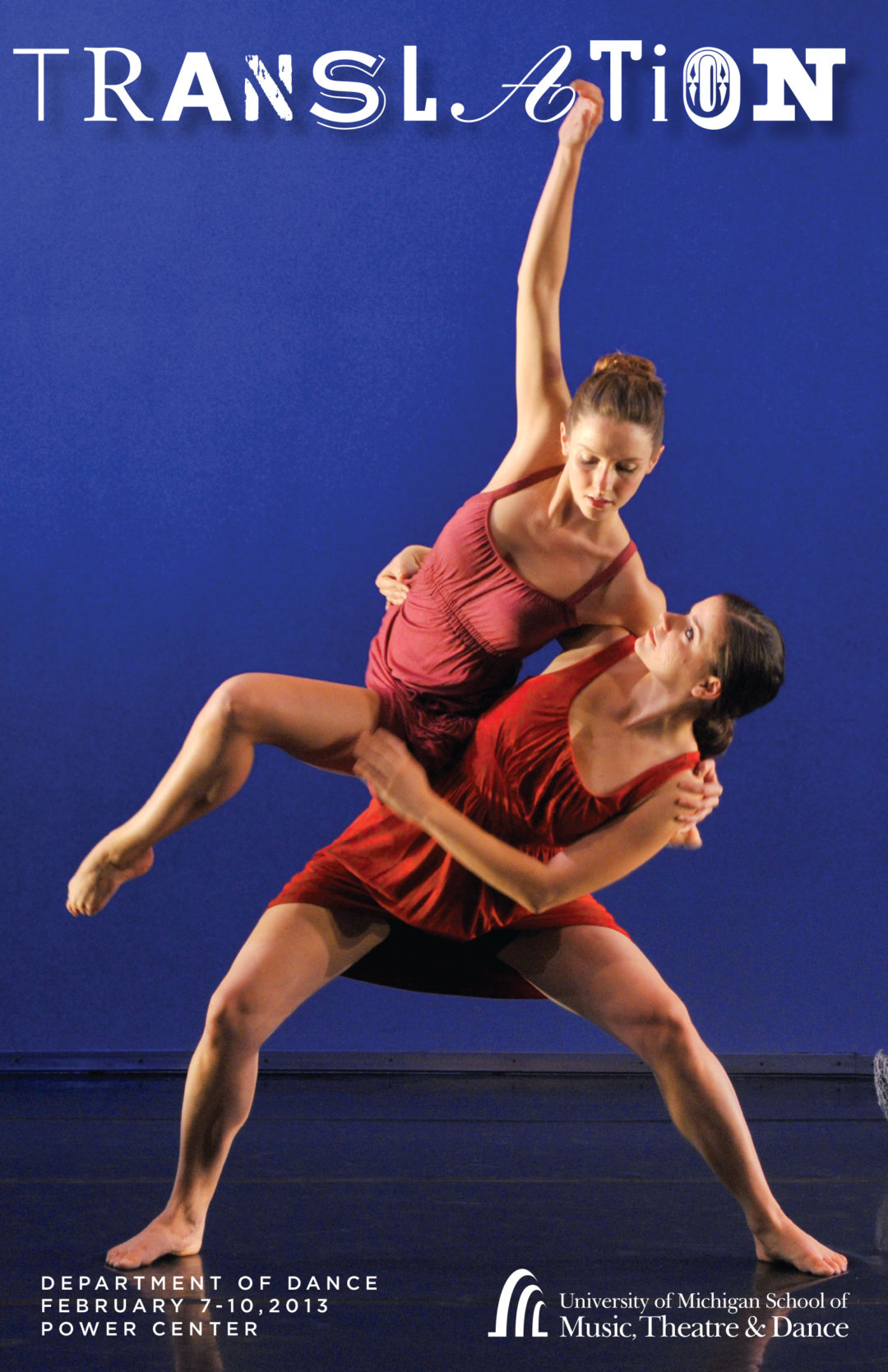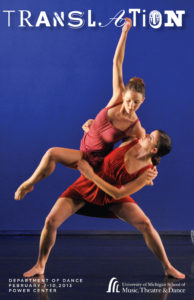Translation
Choreography by Bill T. Jones and faculty Amy Chavasse, Jessica Fogel, and Sandra Torijano
Department of Dance
February 7-10, 2013 • Power Center
The Department of Dance presents Translation, a concert featuring four works by Bill T. Jones and faculty. Choreographer Jessica Fogel presents Hath Purest Wit: Anagrams for Eight Dancers and Thirteen Letters, inspired by the writings of Marcel Danesi (The Puzzle Instinct). Dancers embody anagrams invoking the act of puzzle solving and insight thinking. Lighthearted and whimsical, the dance includes narration from Danesi’s writings and Lewis Carroll. Intrigued by the sideshow celebrities at state fairs, Amy Chavasse creates Headless Woman, an homage to the curiosities that scintillate our imaginations. A new work by Sandra Torijano explores Latin American art and poetry. Highlighting the concert is the first movement of the 1989 Bessie Award-winner for Choreography, D-Man in the Waters, by the multi-talented Bill T. Jones. Created shortly after the death of his partner Arnie Zane from AIDS and dedicated to a dancer fighting his own battle against the disease, D-Man in the Waters celebrates the resilience and survival of the human spirit. Set to Mendelssohn’s “Octet for Strings in E-flat,” the dance is a “joyously defiant affirmation of life. (NY Times)”
Artistic Staff
Artistic Director: Judy Rice
Stage Manager: Michael Barbour
Repertoire & Performers
[accordion title=”Hath Purest Wit”]
Anagrams for Eight Dancers and Thirteen Letters
Choreography by Jessica Fogel, in collaboration with the dancers
Scenic Design by Kasia Mrozewska
Costume Design by Suzanne Young
Lighting Design by Mary Cole
Music Collage & Text arrangement by Jessica Fogel
Music: “Hallelujah Junction” by John Adams, “Let’s Twist Again” by David Appell and Kal Mann
Text excerpts from: Through the Looking-Glass by Lewis Carroll, The Puzzle Instinct: The Meaning of Puzzles in Human Life by Marcel Danesi
Narrator: Leigh Woods
Dancers: CJ Burroughs, Kristen Donovan, Ashley Manci, Jimi Nguyen, Catherine ‘Caty’ Raupp, Stefania Spadaro-Bliss, Alexis Turner, Cara Zonca
Understudy: Lena Oren
Choreographer’s Note:
Commissioned by U-M’s Arts Engine for the conference “The Role of Art-Making and the Arts in the Research University” and premiered May 5, 2011, Hath Purest Wit was created for and performed in the Duderstadt Center atrium on North Campus. The dance sought to express a key neurocognitive element of the creative process – insight thinking. Making the dance and performing it were both akin to attempting to solve puzzles with many possible solutions.
Now, a new space, new puzzles to solve, and new insights have spurred another version of Hath Purest Wit. This time, at the Power Center, you are welcomed into the creative process. An interactive performance installation in the lobby invites you to translate what you see into words or sketches. What you see and interpret in the lobby is re-imagined onstage, not just through movement but also through music and text. Making and experiencing art form part of a buoyant, flexible, ongoing process.
[/accordion][accordion title=”Aria Vitale”]
Choreography by Sandra Torijano
Scenic Design by Kasia Mrozewska, inspired by the mural Girasol (Sunflower) by Eduardo Torijano
Costume Design by Suzanne Young
Lighting Design by Mary Cole
Assistants to the Choreographer: William McClellan, Natalie Niegarth
Music: “A Un Giro Sol” by Claudio Monteverdi, “Bachianas Brasileriras #5” by Heitor Villa-Lobos, “Violin Partita #3: Preludio” by Johann Sebastian Bach, “Una Patada En Los Huevos” by Alberto Iglesias
Dancers: Kaliana Basoukeas, Kula Batangan, Alison Coleman, Allie Harris, R. Sumi Matsumoto, Katie Muth, Chrissy Papetti, Nola Smith, Julia Smith-Eppsteiner
Choreographer’s Note:
This “rhapsodic” choreography, consisting of four sections, presents the poetry that speaks of love, humanity, and farewell mixed with a spontaneous spring spirit. It is a “song” of the body expressing vitality, yearning, and sadness. One section adagio and another quick and dynamic, this performance presents a panorama of expression to the music of Monteverdi, Villa-lobos, Bach, and Alberto Iglesias.
A un giro sol ( Sunflower) by Monteverdi
Your lovely eyes bless everything they see
and with one glance, what is seen seems changed.
Look at the wind, you whisper and the trees
calm and the long grass rises on its stems;
and when you say The night is lovely, the shore
stills as though while tilting back in bliss
the moon forgot its tides. My darling, stare
one dawn unflinching on the sun, I swear
the birds that day will soar in different skies.
Yet there remain two things that cannot change:
the suffering and the grief within my eyes,
and the knowing that when you were born
with a soul so cruel and so unkind,
my heart was cursed to love you and to die.
Aria by Villa-Lobos, Lyrics by Ruth V. Correa
In the early evening floats a cloud transparent and rosy
Infinite the sky of beauty and dreaming
Then the Moon appears as day comes to a closing
Decorating sky as if a girl that’s preening
Who so anxious, trying to make herself so pure
Yearning deep in her soul she seems to be crying
Crying to the sky and to the earth and all Nature
Silent all the birds stop, listen the Moon is complaining
And the sea reflecting the pain, her splendor
Softly now you know the Moon is just waking
Homesick with the feeling that weeps while it’s laughing
In the early evening floats a cloud transparent and rosy
Infinite the sky of beauty and dreaming
[/accordion][accordion title=”Headless Woman (2013)”]
Choreography by Amy Chavasse, in collaboration with the dancers
Scenic Coordination by Kasia Mrozewska
Costume Design by Suzanne Young
Lighting Design by Mary Cole
Video by Caroline Chavasse
Assistant to the Choreographer: Brittany Whitmoyer
Headless Woman Painting by Amy Chavasse, Caroline Chavasse
Tiger by Marguerite Ramm
Throne built by Franz Cattachio
Music by Andy Hasenpflug
Dancers: Lynsey Colden, Isabella Ingels, Hillary Kooistra, Jennifer LaFreniere, Ayana McPherson, Jeffery Noble, Riley O’Donnell, Alejandro Quintanilla, Ambika Raina, Sammi Rosenfeld, Irene Vandenberghe, Nadia Weeks, Michaela Wood
Choreographer’s Note:
The story of the headless woman is true. While visiting my father in North Carolina a few years ago, I came across an article in the local paper that interviewed a young woman who had taken a job as the headless woman in a sideshow at the NC State Fair. She explained how, on a lark, she signed on for this unusual job – how she had transformed or translated her known life into something bizarre and new, how she wanted to see life through a completely different lens. I was intrigued and riveted by the possibilities for a dance/theater endeavor. It was first translated from newspaper story to stage in 1998, with a cast of characters – the headless woman, the MC, the carnival barker, the flame swallower, the tattoo lady, the tiger woman, and the accordion player – to create a world of captivating misfits.
[/accordion][accordion title=”D-Man In The Waters Part I (1989, revised 1998)”]
Choreography by Bill T. Jones
Staged by Germaul Barnes
Costume Design by Liz Prince
Lighting Design by Robert Wierzel
Rehearsal Director: Judy Rice
Rehearsal Assistants: Sammi Rosenfeld, Hillary Kooistra
Music: “Octet for Strings in E-flat Major, Op. 20” (1825) by Felix Mendelssohn
Dancers: Kula Batangan, Sabrina Imamura, William B. McClellen, Jr., Katie Muth, Jimi Nguyen, Jeffery Noble, Maxx Passion, Alejandro Quintanilla, Nola Smith
Understudies: Allie Harris, Briana Stuart, Katy Telfer, Nadia Weeks
“In a dream you saw a way to survive and you were full of joy.” – Jenny Holzer
This dance is dedicated to Demian Acquavella.
Choreographer’s Note:
The first movement of D-Man In The Waters was commissioned by the St. Luke’s Chamber Ensemble in 1988 and was made possible with funds from the New York State Council on the Arts.
[/accordion]
Sponsors
The School of Music, Theatre & Dance acknowledges the generosity of McKinley Associates, Inc. whose support has helped make this production possible.
Resources
[accordion title=”From the Chair”]
Welcome to Translation. Tonight’s program offers multiple insights into how choreography is conceived, embodied and re-interpreted. The art of transference is an underlying theme – how dances are re-imagined in new spaces and on current students; how they relocate from the rehearsal studio to the stage and from the lobby to the proscenium. The moment of performance is itself a transitive state. Dancers and audience members construe meaning through simultaneous translation. The Department of Dance is delighted to share multiple movement languages with you this evening and to showcase the wide-ranging talents of our students and faculty.
— Angela Kane, Chair, Department of Dance
[/accordion]


